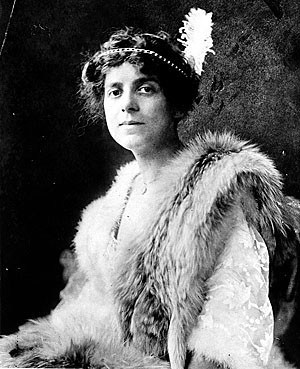In a St. Louis parlor room in the summer of 1913, two housewives bent over a Ouija board. Thirty-year-old Pearl Curran had recently lost her father. Her friend, Emily Grant Hutchings, urged her to try to contact him through the game. The women placed their hands on the board's heart-shaped planchette and asked if anyone was there. In the silent, humid room, the planchette's circular eye began to move across the board's letters — but it wasn't Curran's father.
"Many moons ago I lived," the board spelled out. "Again I come. Patience Worth my name."
At the turn of the 20th century, the country was obsessed with spiritualism. Séances and hypnotism were forms of entertainment in the households of the middle- and upper-classes, and the interest in contacting ghosts was as fervent as the interest in debunking so-called psychics and mystics. It was in this era that Curran first took up the Ouija board and met Worth, a spirit who would stay with her until her death in 1937. Across two decades of medium sessions, Curran penned seven novels supposedly dictated to her by Worth — along with countless poems and essays — in total, more than four million words from beyond the grave. Throughout their shared career, Curran faced many critics who sought to disprove Worth's existence.
"The mystery of it all fascinated me," says Daniel Shea, professor emeritus of English at Washington University and author of The Patience of Pearl: Spiritualism and Authorship in the Writings of Pearl Curran.
The daughter of a newspaperman, Pearl Lenore Pollard grew up with knowledge of words but was by all accounts relatively uneducated, with little interest in literature and books. She married John Curran, a St. Louis immigration official, at age 24 and spent her days tending to the domestic chores of a housewife. Several years into her marriage, Curran became friends with Hutchings, the wife of the secretary of the Tower Grove Park Board, and like many bored housewives of the time, began exploring spiritualism.
In July 1913, the voice of Worth — a woman who died in the 17th century — first appeared through the Ouija planchette. Worth revealed that she was the spirit of a Puritan who had traveled from Dorsetshire, England, to Nantucket Island, Massachusetts, before being killed in a Native American raid. An aspiring author in a new land, Worth lamented to Curran that her death occurred before she could complete her life's work. Through the Ouija board, Curran offered to help with Worth's unfinished business. The two women, one living and one dead, began to correspond regularly.
In her transcriptions through Curran, Worth revealed very little of herself. She conveyed scant information about her voyage from Dorsetshire to New England, transmitting only, "About me, thou wouldst know much. Yesterday is dead. Let thy mind rest as to the past." Her archaic diction convinced observers that the voice was most certainly not Curran's. Worth's spirit became known for her cleverness and witty turns of phrase. She often played with observers, especially those who voiced their doubts, such as when a doctor asked Worth to overturn the board so he could see the underside and she spelled out, "Thee'lt bump thy nose to look within the hopper." She was also known to communicate in anachronistic maxims and aphorisms, spelling out adages such as, "An old goose gobbles the grain like a gosling," and, "Dead resolves are sorry fare."
Given the time's popular interest in spiritualism and the existence of four major daily newspapers in St. Louis, word of Curran's medium sessions with Worth spread quickly. Curran's husband's prominent job helped too. Writers, psychologists and those occupying the highest echelons of society would come to the Currans' parlor room to witness Pearl at the Ouija board, dictating words letter by letter to her husband John, who dutifully wrote them down. Onlookers could sometimes observe the penning of one or two complete poems in a single session. That drew the interest of Casper Yost, an editor at the St. Louis Globe-Democrat, who wrote a series of articles for the newspaper that became the 1916 book Patience Worth: A Psychic Mystery. In it, Yost describes Curran as "a young woman of nervous temperament, bright, vivacious, ready of speech. She has a taste for literature, but is not a writer, and has never attempted to write anything more ambitious than a personal letter." He paints Worth as an intelligent spirit by contrast, one whose mind was "at once keen, swift, subtle and profound. There is not once but always a sustained level of clear thought and fine feeling." For this reason, and because Worth also wrote with such authority about the 17th century, Yost believed what he was witnessing to be a true supernatural phenomenon. He wrote, "[Worth] is surprisingly familiar with the trees and flowers, the birds and beasts of England. She knows the manners and customs of its people as they were two or three centuries ago, the people of the fields or the people of the palace."The book launched Curran and Worth into the national spotlight. Curran traveled to Hollywood to advise movie stars in medium sessions. She consulted with psychologists who sought a scientific explanation for the prolific nature of Worth's writings. The pair's books also enjoyed success. Their first novel, The Sorry Tale, published in 1917 to rave reviews, and The Anthology of Magazine Verse and Year Book of American Poetry included five of the women's poems. In 1918 the Joint Committee of Literary Arts of New York selected Worth — a ghost — as one of the nation's best authors. The dead woman was always listed as the author; Curran was regarded as only a medium who put Worth's words to paper.
As Worth's fame grew, Curran was required to travel and perform medium sessions for audiences. Shea says she began to travel without the board. "She put away the Ouija board and just spoke it," he says. "She held onto a handkerchief for concentration." Curran would say, "Let's see what Patience has to say about that," before answering in Worth's more high-pitched voice and old-fashioned language.
In 1919 a professor of philosophy at Washington University named Charles E. Cory published an article entitled "Patience Worth" in The Psychological Review suggesting that Curran might have multiple personality disorder. Having attended several of Curran's medium sessions, Cory surmised that she suffered from a severe dissociation between her daily life of household drudgery and her evenings of speaking and writing in Worth's voice. "Mrs. Curran is an intelligent woman, but her mind is much inferior to that of Worth. In short, here is a subconscious self far outstripping in power and range the primary consciousness. This is an indisputable fact, and it is a significant one for psychology," he wrote. Cory concluded, "To Mrs. Curran falls the care of the needs of the body, and the interests of the social life. From all this Worth is free."

As interest in spiritualism receded, so did the rave reviews of Worth's works. The pair went on to publish more books, stories and poems, but the novelty of her writings subsided even if curiosity about the case did not. Psychologists and neuroscientists continued to seek a rational explanation for Worth's existence. In 1921, Yost traveled to England to find Worth's birthplace and evidence that someone like her really had lived there, but he was never able to find substantial proof.
After Curran's husband passed away in 1922, she needed money. The couple never charged onlookers who came to their parlor-room sessions, and they saw no profit from Worth's novels. She began traveling the country performing medium readings for a fee. Curran communicated with Worth right up until her death in California from pneumonia in 1937, which was allegedly predated by a final Ouija board session. Worth allegedly predicted the illness several weeks ahead of time, though Curran never revealed that transcript. Instead she told a friend shortly before her death, "Patience has just shown me the end of the road, and you will have to carry on as best as you can."
Shea finds it a fascinating study in neuroscience and psychology. "Pearl is an extraordinary example of that dimension of creativity," he says. "She had to learn passivity in a good sense, that is, to be open to everything that was within her, otherwise she wouldn't have come up with Worth on the board. She would have pushed."
So, was Curran truly channeling the spirit of a dead woman, suffering from some kind of delusional disorder, or was she merely a con artist? The mystery of Patience and Pearl was never solved — unless, of course, Curran showed her hand after all.
In 1919, the Saturday Evening Post published a short work of fiction called "Rosa Alvaro, Entrante." For the first time in her career, the byline read "Pearl Curran" and not "Patience Worth." The story followed a bored department-store clerk who seeks the advice of a clairvoyant, desperate for a better and more exciting life. The clairvoyant tells the clerk that the spirit of a Spanish woman named Rosa Alvaro has been following her since childhood, and the clerk begins to slip into the accent and lifestyle of her ghostly companion. But by the end of the tale, the narrator admits that Rosa is just a figment of her imagination, a scam. "I was sick of myself. I wanted to feel, feel like a woman that somebody cared about," the narrator says. "What's the use of me? Nobody ever sees me."
"It's very close to Pearl's early experience working at Marshall Field's and how dull all of it was," Shea points out.
Curran's confession via fiction — if that's what it was — went largely unnoticed.
Editor's note: After receiving her degree from Washington University, author and St. Louis native Anne Valente moved around quite a bit and now lives in Cincinnati. But her thoughts continually return to her hometown and, in particular, one aspect of it. "I think it's just a fascinating place and one I'm excited to dig into more and uncover things I might not have known growing up," she says. "The city has always been kind of quirky and strange, and some of those creepier stories are ones that interest me." Currently, Valente says, all of her fiction is set in St. Louis, but she doesn't just pull from her own memories — she dives into some of the area's weirder history for inspiration. That's how she came across the story of Pearl Curran and her ghostly coauthor, Patience Worth. Although Valente has a forthcoming short fiction story which draws upon the tale, the actual facts of the case are fascinating all on their own, and she wanted to share them with Riverfront Times readers in honor of Halloween. Valente will be at Left Bank Books on Monday, November 10, at 7 p.m., and Subterranean Books on Tuesday, November 11, at 6 p.m. to read from her short fiction collection By Light We Knew Our Names.






